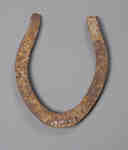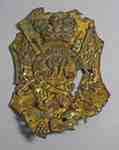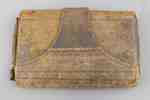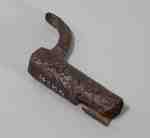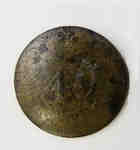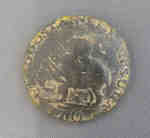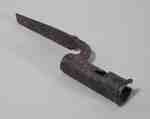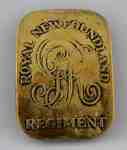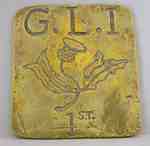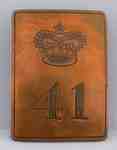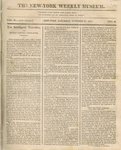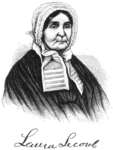Results




Page 3 of 4
- A horse shoe unearthed at one of Niagara’s Battlefields. This item is on display at the Battleground Hotel Museum.A horse shoe unearthed at one of Niagara’s Battlefields. This item is …
- This book contains a variety of documents concerning the campaign upon the Niagara frontier in 1813. Documents include both military and domestic topics from a variety of sources. It also includes aThis book contains a variety of documents concerning the campaign upon the …
- A map of the Niagara Frontier which shows 1812-1814 battle sites. Possibly from "Lossing's Field Book of the War of 1812" dated 1869.A map of the Niagara Frontier which shows 1812-1814 battle sites. Possibly …
- This is an officer’s gold plated shako plate. The design shows the Royal cipher surmounted by a crown and encircled by a belt that has “ROYAL REG. OF ARTILLERY” inscribed on it. This plate was foundThis is an officer’s gold plated shako plate. The design shows the …
- Made of brown leather, this typical early 19th century wallet has a tongue flap to close the wallet and opens flat for access to the two compartments. Brown pebble finish leather, inside pockets andMade of brown leather, this typical early 19th century wallet has a …
- This is a bayonet socket with a small portion of the blade attached that was discovered in the Niagara River. A bayonet is a steel blade that is designed to fit on the muzzle of a rifle or musket barThis is a bayonet socket with a small portion of the blade …
- The button is made of metal, possibly pewter and measures 2 cm in diameter. The face of the button has the number “49” raised in the center. The 49th Regiment of Foot came to Canada in 1803 and was tThe button is made of metal, possibly pewter and measures 2 cm …
- On leaf preceding the t.p.: Battles of Chippawa and Lundy's Lane, by Charles Anderson, guide to the battle ground. On box: Chippawa and Lundy's Lane. Printed by John SimpsonOn leaf preceding the t.p.: Battles of Chippawa and Lundy's Lane, by …
- This button has a relief crown and field gun facing proper right. It is believed to be from the Royal Artillery and measures 2 cm in diameter.This button has a relief crown and field gun facing proper right. …
- This button is believed to have belonged to a member of the 76th Hindoostan Regiment that were in Niagara from 1812-1814.This button is believed to have belonged to a member of the …
- This photograph of a plan is titled “American Piquete Round Fort George Summer 1813". It was obtained by the Museum from the “National Archives of Canada, Cartographic and Architectural Archives DiviThis photograph of a plan is titled “American Piquete Round Fort George …
- This is a bayonet socket with a portion of the blade attached that was discovered in the Niagara River. A bayonet is a steel blade that is designed to fit on the muzzle of a rifle or musket barrel, mThis is a bayonet socket with a portion of the blade attached …
- This is a fragment of a triangular bayonet blade, dated from the War of 1812-1814, that was discovered in the Niagara River. A bayonet is a steel blade that is designed to fit on the muzzle of a riflThis is a fragment of a triangular bayonet blade, dated from the …
- This is an oblong, convex brass plate for a soldier’s cross belt from 1803-1812. It is stamped with the cipher “GR” and “Royal Newfoundland Regiment”. This regiment served in Niagara during the War oThis is an oblong, convex brass plate for a soldier’s cross belt …
- This rectangular bass plate is stamped with a crown and “GR” cipher with an inscription: “MAIDA” (above crown) and “Reg. de. Watteville” (below cipher). This item is from a cross belt of a uniform ofThis rectangular bass plate is stamped with a crown and “GR” cipher …
- This brass cross belt plate was fashioned to represent the Glengarry Light Infantry Fencibles. The rectangular plate is stamped with the initials “GLI” and the number one for 1st Battalion. There isThis brass cross belt plate was fashioned to represent the Glengarry Light …
- This brass cross belt plate is stamped "41" and a crown which was created to represent the Forty-first Regiment of Foot, also known as the Welsh Regiment.The first battalion came to Canada from IrelaThis brass cross belt plate is stamped "41" and a crown which …
- A weekly paper that was published from 1805 to 1814. War related news includes: Page 99 - Weekly Retrospect: American report on British naval movements near Louisiana; General William Harrison reportA weekly paper that was published from 1805 to 1814. War related …
- Black and white woodcut ink portrait of Laura SecordBlack and white woodcut ink portrait of Laura Secord
- Black and white image of cameo-style portrait of a young Laura Secord.Black and white image of cameo-style portrait of a young Laura Secord.
Page 3 of 4
When selecting an individual record or object, you will move
to the website of the heritage institution that houses the item.
To return to the search or results pages, select "Back", "Results" or "New Search".
 This project was made possible with the support of the Department of Canadian Heritage
This project was made possible with the support of the Department of Canadian Heritage
through the Canadian Culture Online Strategy.
to the website of the heritage institution that houses the item.
To return to the search or results pages, select "Back", "Results" or "New Search".
 This project was made possible with the support of the Department of Canadian Heritage
This project was made possible with the support of the Department of Canadian Heritage through the Canadian Culture Online Strategy.


